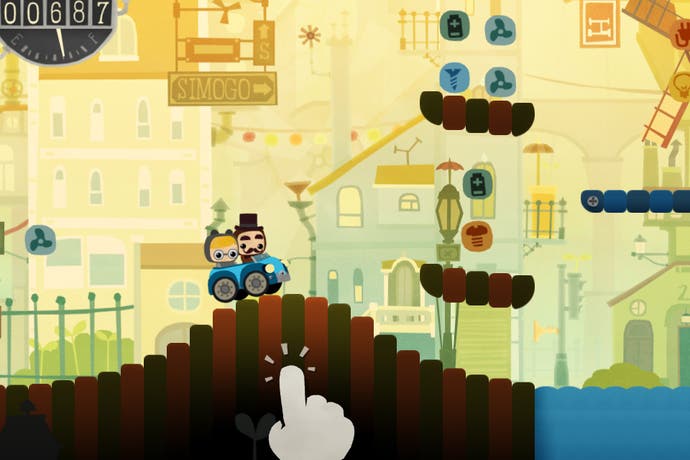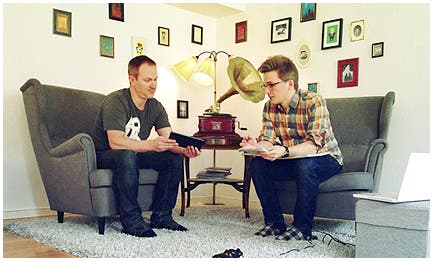The evolution of Simogo
The creators of 2013's most creative games reflect on their ascendance.
"If we had a mission statement now, it would probably say something like, "We make what we feel like making.'"
Swedish developer Simogo had a hell of a 2013. Until recently the duo of Simon Flesser and Magnus 'Gordon' Gardebäck created games like Kosmo Spin, Bumpy Road and Beat Sneak Bandit - punchy little mobile titles with clever control schemes and adorable mascots. But over the last 12 months the studio's work has dramatically evolved, resulting in two of last year's most creatively diverse iOS games, Year Walk and DEVICE 6.
Indeed DEVICE 6 recently earned either a nomination or an honourable mention in every single category at the upcoming Independent Game Festival, an achievement unprecedented in the history of the awards. It highlighted Simogo's current position as one of the most exciting studios on the planet.

Go back a decade, however, and the art, design and audio half of Simogo wasn't even interested in making games. In the early 2000s, while working as an animator on movies and commercials, Simon Flesser felt that games were in a pretty uninteresting place. Then, in 2004, the Nintendo DS arrived with its touch-sensitive screen and a new set of inputs. His imagination was lit.
"I didn't feel a great need to create games before the DS," explains Flesser. "It felt so fresh! Suddenly there were lots of possibilities to create your own rules about interaction. And lots of games showed the way too, with new and fun ways to play: Ouendan, Pac Pix, Yoshi's Touch & Go, Another Code..."
This newfound enthusiasm led Flesser to take a role at Malmö's Southend Interactive in 2007, producing art for XBLA titles like R-Type Dimensions and ilimilo. It was there that he met programmer and designer Magnus Gardebäck, kick-starting a friendship that would result in the duo striking out on their own in 2010. That's how Simogo began, and the desire to find new methods of interaction has defined its work.
"We really enjoy 'inventing' new controls," says Flesser. "How a game feels in your hands, is something we consider very important.
"A big part of what we do is trying to make unique things, and the way you interact with a game is the most immediate 'feel' of it for the player. So that's why we strive to make that interaction new. It's very refreshing starting with a totally clean slate, every time."
This is evident even in Simogo's early games. Kosmo Spin's embroidered world whirls with a swipe, Bumpy Road's cobbled streets undulate at your fingertips, and Beat Sneak Bandit's titular cat burglar slips past guards with a rhythmic tap. The studio's ability to tease inventive controls from capacitive glass is exhilarating.
"We've made one prototype for a game controlled with a standard controller," says Flesser of a rare experiment beyond touchscreen devices. "And we really struggled to create something that felt both fresh and natural. It was a pitch we made in 2012, which led to long interesting discussions but ended up being put on hold." For Simogo, it's either new or it doesn't get made.

The studio's unsuccessful foray away from touchscreens was probably for the best. Unsatisfied by the experience, Simogo returned to iOS and the development of its most ambitious game yet, Year Walk.
In what Flesser says was a deliberate attempt to "challenge people's perceptions of what a Simogo game is", Year Walk shuns the warmth and charm of the duo's previous games in favour of monochromatic horror. A two-dimensional adventure game that demands swipes and pulls to explore creepy snowbound environments, as well as clever interactions to solve puzzles, it's a dramatic extension of Simogo's ideals.
Part of what makes Year Walk so remarkable is how it adapts a short movie script called Årsgång, written by Flesser's childhood friend, Jonas Tarestad. Drawing on Swedish folklore, it's a world of infanticide, night ravens and myths so unfamiliar that Simogo created a companion app to explain the history and, in a brilliant twist, offer a thrilling epilogue to the unsettling story.
Flesser is proud of Year Walk's combination of unusual references and intuitive gameplay, something he feels is lacking elsewhere in the games industry.
"I think a big problem is that a lot of game creators only look to other games, or to the same type of inspirations," he says. "Even a lot of games that are considered to be very creative are very reliant on videogame culture in their references and inspirations. It's not necessarily a bad thing, but it's not something we're interested in creating.
"I mean, I love Fez and Sword & Sworcery, but they're not something I could show my parents and say 'look how great this is!' because you need to have some kind of starting point in the culture that they're from, in order to take it in.
"We don't make a point out of making something that everyone should 'get', because you'll end up with something very bland. But by being inspired by things that are not usually sources of inspirations for videogames, they end up being a lot more accessible to people who are not as well traversed in the medium. And I think that's why they also feel fresh and surprising to gamers. Win-win!"

Unusual inspirations, genre twists and inventive interactions - Simogo's hallmarks were already established by the time Device 6 appeared in October last year. Yet still the studio had the power to surprise.
"While Year Walk was a liberal interpretation of an already created story, Device 6 was a story that Jonas Tarestad and I developed together," explains Flesser. "We knew we wanted to make something that would thematically be far away from Year Walk. Something sci-fi influenced, futuristic, but with the future predicted by by someone in the 1960s, with strong sense of social commentary."
"So I came up with the larger framework, the meta-story, the lore, sort of everything between the lines so to speak, while Jonas concentrated more on the direct narrative, Anna's story."
Anna is the game's protagonist, who wakes up in an uncanny castle with no memory of how she arrived. Attempting to escape, she encounters creepy mannequins, automaton-monkeys and shadowy men in bowler hats, unravelling a mystery with a hugely subversive climax. It's brilliant, but it's not the most notable thing about the game.
Nearly everything in Device 6 is made up of text, punctuated by grainy images and distorted audio cues. As Anna explores and the player scrolls through the story, the words wind up spiral staircases and round corners along with the character. Within each chapter is an impasse, a locked door or a security panel, the solution to which can be found hidden, obfuscated within the proceeding passage.
"How a game feels in your hands, is something we consider very important."
Simon Flesser

"I'm not sure everyone gets that the text in Device 6 is actually very literal," elaborates Flesser, before going on to explain that the game's words don't just shift direction and orientation for stylistic effect, they actually make sense geographically. "I made rough maps of every place in the game, then laid out the text to fit them," he says. It's a detail that will be lost on most players, but nevertheless lends the remarkable setting a sense of plausibility.
Device 6 highlights just how far Simogo has come. A clear evolution of the studio's ambitions, it's the culmination of everything Flesser and Gardebäck have been working towards. It's also remarkable that the titular devices featured in the game allude to those found in the CiNG title, Another Code. Three years, five games and some huge creative leaps later, the Nintendo DS titles that inspired Flesser to embark on a career in game design are still exerting their influence.
In some ways then, DEVICE 6 feels like the end of a chapter in Simogo's history. Following the studio's outstanding 2013, Flesser and Gardebäck are currently working on bringing Year Walk to Steam, complete with new areas and reworked controls and art.
So is Simogo considering a permanent move away from iOS, and does Flesser feel any pressure to keep innovating at the studio's currently astonishing rate?
"In some ways, for sure, there's always some pressure involved if you've 'made a name for yourself', but a lot of what Simogo stands for is to constantly surprise," he says. "It would be fun to try out other platforms. Year Walk on Steam is perhaps us dipping our toes a little."
Whatever the future holds, if Flesser and Gardebäck's work continues to evolve and surprise, Simogo's position as one of the industry's most inventive studios seems assured.
